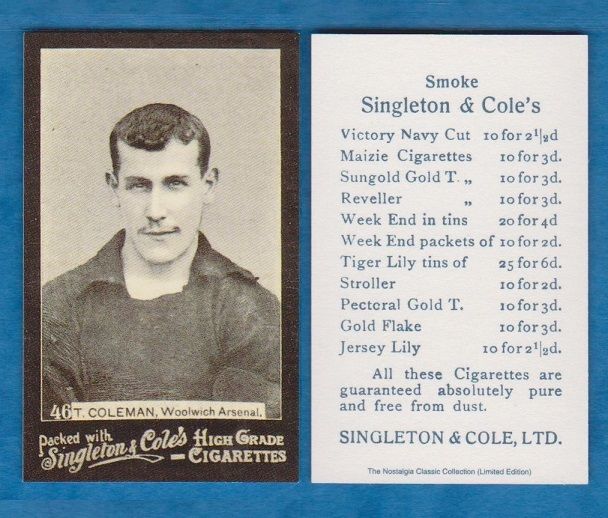Tim Coleman was a footballer who wowed crowds and journalists alike, thrilling Arsenal fans for six years before the war brought an end to his playing days and a fall from a roof took his life.

Christened John George Coleman, ‘Tim’ (Timmy) Coleman was born to Julia Ann Butlin and George Coleman in Kettering in 1881, five years before Arsenal were formed.
An inside right, Coleman signed for Arsenal in 1902 and went on to score 84 goals in 196 games for the club before leaving in 1908 for Everton where his goalscoring continued. 30 in 71 with the Toffees was followed by 20 in 32 for Sunderland, 45 in 94 for Fulham, 14 in 37 for Nottingham Forest and, to finish off his career, before he moved into management in the Netherlands, 39 in 37 for Tunbridge Wells Rangers.
In truth, the First World War put an end to his playing career, returning to play for non-league Rangers only in 1920 after leaving Forest as a professional in 1915. He hung up his boots for good in 1921 and moved to the Netherlands
When Coleman first arrived at Arsenal, he broke the club’s scoring record, putting away 17 goals in just 30 games and was a leading light that, along with Tommy Shanks, helped guide Arsenal in to the First Division for the first time with 23 goals in 28 games. Shanks scored 25.
Arsenal hadn’t wanted to sell Coleman to Everton, but the £350 offer (not £700 as detailed on Wikipedia although you can see below where the confusion comes from) was too much to reject for the club, struggling as they were financially at the time.
“The transfer of Coleman from Woolwich Arsenal to Everton must have caused much consternation to all who have the interests of the Plumstead club at heart,” Cricket and Football Field reported on 29 February 1908.
“l am told on good authority that the public may assume that the Woolwich officials “have good reason for what they have done.” I should like to know what the reason is. If it be merely a temporary loss form it ought not to have weighed with the Arsenal any more than it has done with Everton.
“If it be that Coleman was dissatisfied, the supporters of the club ought to know why. Coleman is a most accomplished player, comparatively young, ever reliable, and for six years has brilliantly justified the choice Messrs. Kennedy and Bradshaw, who discovered him for the Plumstead club.
“Now, immediately following his benefit match, he has been transferred to one of the best teams in the country for paltry £350. Incidentally, he is accompanied from Woolwich to Everton by one Crewes, a reserve outside left who may be “promising,” but who has never once appeared in first-class football. The double fee paid by Everton amounts to “about” £600.
“It is not for us to suggest that the two clubs concerned are the first “to drive coach-and-four” through the new rule of the Football Association, but I certainly contend that Woolwich Arsenal have not got full value for “Tim” Coleman by accepting the maximum transfer fee for his services.”
Tim Coleman was a player described as having ‘clever anticipation and skill in making openings’ as well as ‘one of the finest inside players of his day’.
Despite his talent, Coleman was selected to play for England just once. His only cap came against Ireland in a game they won 1-0.
Tim Coleman death
According to Wikipedia, Timmy Coleman died on 20 November 1940 in St Mary Abbot’s Hospital after falling off the roof of a power station in South Kensington while at work. Papers from the time, however, say he passed at home of his son. Either way, it is a stark reminder that football at the top level didn’t bring untold wealth until fairly recently.
The Nottingham Evening Post seemed to have provided the most detailed obituary of the player and reported his death as follows:
“FAMOUS FOREST FOOTBALLER
“Tim” Coleman Killed By Roof Fall

J. G. Coleman, footballer of international renown, who wore the red garibaldi of Nottingham Forest in the first season of the first World War (1914-15) has died following accident at work when he fell from a roof.
Tim,” a very genial character, joined the City Ground Staff on July 18th, 1914, and in his one season with the “Reds” made 39 appearances (2 in the Cup) and was top scorer with 16 goals (2 in the Cup).
He joined the Footballers Battalion, in numerous games for Forest appearing on the programme as Tim Coleman. Private Coleman, and in that unit served under Major F. Buckley, and had Tom Gibson, another Forest footballer, as his sergeant-major.
As inside-right Coleman saw service with Northampton, Woolwich Arsenal, Everton, Sunderland, and Fulham, prior to joining Forest. He played for England against Ireland at Goodison Park in 1907, and for the League against Scottish and Irish Leagues the same year. At the outbreak of war in 1939 Coleman was football coach in Holland.”

